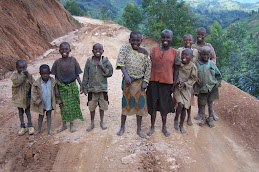Tuesday Jan 15th
Today was our final Kinyarwanda lesson. It was a review of all we’ve done (makes an impressive list but we’ve done it so quickly it hasn’t had much chance to sink in ). More role play with language – Marisa and I did a convincing impression of hiring a moto ride.
More heavy rain a.m.; so cold we all needed fleeces on. The weather here is peculiar; it can suddenly go very cold – down to English temperatures – but then just as quickly the sun will come out and sky clear and we’re in equatorial Africa within five minutes!
My stomach is just about back to normal, thank God. But I get the impression my errant bowels have been a topic of conversation at the Programme Office because everyone seems to be asking me how I feel. Embarrassing or what?
Late morning we have a Global education talk (what was that all about?), then a quick evaluation of the whole In-Country Training course with Gerard (a visiting assessor from Nairobi).
After lunch the atmosphere gets sombre. We visit the Genocide Museum in Kigali. We’re shown mass graves, one deliberately left open with coffins visible. There are bouquets of lowers left everywhere, and as a group we add ours. It’s a beautiful museum building with landscaped gardens, everything symbolic such as a circular pond representing a pre-genocide unified Rwanda, then a star shaped pool to signify disunity.
I thought that having been to both Auschwitz and Yad Vashem I would be hardened to this sort of thing, but no chance. After about two hours we all felt a desperate need to come back to the living. This genocide museum really gets you in the throat. Why? Is it the COLOUR photos as compared to the black and white of world war 2? Or is it he recent-ness – we can all remember it all happening while our Governments stood by?
It is beautiful clear air and late afternoon light; Kigali’s looking wonderful. The road back from the Museum crosses a swampy valley with slums – sewage strong enough to smell through car windows. Then immediately, up the next hill, we’re in the embassy quarter with the new U S fortress in a prime site and luxury hotels along the roadside. What a difference a few hundred yards can make in this country!
Some of us stopped in town to send e-mails; I spent a frustrating 4 minutes before I could even get logged on properly. I think all the machines are riddled with viruses, and there is clearly no broadband connection except in a very few favoured locations in the city centre (and I haven’t located these yet). We walked back to Amani through rush hour traffic. The roads are dark roads, there are deep gulleys to fall into and traffic whizzing past very close, and yet drivers and pedestrians all seem calm. We, too are beginning to get used to being out on the street and feel more relaxed.
After the museum everyone was very subdued. It was especially hard for Tiga – she has both Jewish and Armenian ancestry, and the room in the museum which described other past genocides besides the Rwandan one was very gruelling for her.
I must describe my shower at Amani. It is an electric gadget attached to the shower head. It looks amazingly suspect in terms of safety and wiring but it does work. However, when I switch it on the room light flickers crazily. I have visions of me electrocuted, naked, in stream of water from shower…. Not a pretty prospect.
Best point of the day – feeling well again. Arranging to get laundry done ready for Gitarama (new sheets etc). Bargain for 50p
Worst point – everything related to the genocide. The waste, the stupidity, the ineffectiveness. And yet you can walk all round Kigali and not be aware that it had ever happened. And places like the Mille Collines back in business serving same types of wheeler-dealer clientele, the new elite of the country.
Tuesday, 22 January 2008
A sobering visit....
Posted by
Bruce's Rwanda blog
at
12:06
![]()
Subscribe to:
Post Comments (Atom)















No comments:
Post a Comment